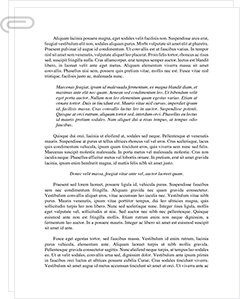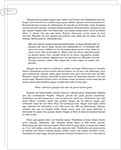 Study Document
Study Document
Role of Religion in Higher Essay
Pages:5 (2043 words)
Sources:5
Subject:Personal Issues
Topic:Role Model
Document Type:Essay
Document:#13208666
These board members are most likely to observe these institutions as corporate business organizations and even instill the idea of top-down management to it. Birnbaum (1988) pointed out dualism of control as a problem of the institutions of learning. Westmeyer (1990) pointed out that certain signs of business theory can be identified in the institutions of higher learning. These includes competition for purchases (clients), the importance and relevance of cost-effectiveness, incentives and sanctions as well as the structured nature of departments. It has also been argued that institutions of higher education are similar to corporate businesses since they are multi-billion dollar business enterprises that are governed similar financial realities of outlay and income as well as by the market forces of demand and supply. Lenington (1996) pointed out that higher education institution's resources are similar to those of any other corporate business entity. They need similar personnel, capital as well as physical plant. A good resource management plan by the institution of higher learning would result in improved productivity and maintenance of costs. Due to the rapidly evolving socio-economic, legal as well as technological changes, the higher education boards have been forced to turn to business leaders as well as government leaders in an effort to respond to these changes (Ferren, 2001). Birnbaum (2000) pointed out that institution of higher learning have also adopted several management innovation that are apoplocable in corporate business scenarios. These include; Zero-Based Budgeting, Strategic Planning, Management by Objectives, Total Control Management, Benchmarking and Business Process Reengineering among others.
References
Birnbaum, R. (1988). How Colleges Work: The Cybernetics of Academic Organizations and Leadership. San Francisco: Jossey-Bass Publishers.
Birnbaum, R. (2000). "The Life Cycle of Academic Management Fads." The Journal of Higher Education. Vol. 71, No. 1, pp. 1-16.
Darnell, A and Sherkat, DE (1997). "The Impact of Protestant Fundamentalism on Educational Attainment." American Sociological Review 62: 306-316.
Ferren, A. (2001). Reconciling Corporate and Academic Cultures. [electronic version] AAC&U Peer Review. Vol. 3, No. 3, pp. 9-11.
Glass, J and Jacobs, J (2005). "Childhood Religious Conservatism and Adult Attainment
among Black and White Women." Social Forces 84: 555-579.
Hood, RW., Hill, PC and W. Paul Williamson, WP (2005). The Psychology of Religious
Fundamentalism. New York: Guilford Press.
Hunsberger, B, Alisat, S. Pancer, M and Prat, M. (1996). "Religious Fundamentalism and Religious Doubts: Content, Connections
Labi, A. (2004,April 9). Bill Allowing Higher Tuition in England and Wales Survives Another. Key Vote. The Chronicle of Higher Education, vol 50, Issue 31
Lenington, R. (1996). Managing Higher Education as a Business. Series on Higher Education: American Council on Education, Oryx Press.
Mooney, M. (2005). "Religion at America's Most Selective Colleges." Paper presented at the annual meetings of the Association for the Sociology of Religion.
Pascarella, E.T., Christopher T. P, Patric T. T, and Gregory C.W. (2004). "First Generation College Students: Additional Evidence on College Experiences and Outcomes." Journal of Higher Education 75: 249-284.
Regnerus, M.D. (2000). "Shaping Schooling Success: Religious Socialization and Educational Outcomes in Metropolitan Public Schools." Journal for the Scientific Study of Religion 39: 363-370.
Sherkat, DE (2007). Religion and Higher Education: The Good, the Bad, and the Ugly. Available online at http://religion.ssrc.org/reforum/Sherkat.pdf
Teferra, D. (2005). Establishing Endowments for African Universities -- Strategies for Implementation. International Higher Education, 38, 22…
Sample Source(s) Used
References
Birnbaum, R. (1988). How Colleges Work: The Cybernetics of Academic Organizations and Leadership. San Francisco: Jossey-Bass Publishers.
Birnbaum, R. (2000). "The Life Cycle of Academic Management Fads." The Journal of Higher Education. Vol. 71, No. 1, pp. 1-16.
Darnell, A and Sherkat, DE (1997). "The Impact of Protestant Fundamentalism on Educational Attainment." American Sociological Review 62: 306-316.
Ferren, A. (2001). Reconciling Corporate and Academic Cultures. [electronic version] AAC&U Peer Review. Vol. 3, No. 3, pp. 9-11.
Related Documents
 Study Document
Study Document
Religion in Public Schools: Religious Fundamentalists Vs.
Religion in Public Schools: Religious Fundamentalists vs. Atheists The relevance of raising children with an insistence on the development of a high moral character cannot be overstated. Essentially, individuals raised with a well founded moral character have the ability to clearly distinguish between bad/unacceptable behavior and good/acceptable behavior. With this in mind, it is understandable that parents usually prefer to have their children undertake their education in an enabling environment that
 Study Document
Study Document
Role of Religion What Is
The ruling stated that, since the moment of silence was for the purpose of advancing religion, it was unconstitutional. This was evidently a case-specific ruling however, and the fact is that the Court has not ruled that this moment of silence may always be unconstitutional. There are multiple court rulings in other jurisdictions that have ruled the moment of silence allowable if it passes the test of not advancing
 Study Document
Study Document
Illustrate Note Explain Roles Religion Sir Gawain Green Knight
Sir Gawain Religion features prominently in the 14th century text Sir Gawain and the Green Knight. The story reveals the interface between indigenous pagan faiths and Christianity, especially as the two converge in the colonized Celtic regions such as Wales. As the story champions the hero, Sir Gawain, a Christo-centric message is being conveyed. Sir Gawain, although a problematic hero, is redeemed through his unwavering faith in Jesus and Mary. Christianity
 Study Document
Study Document
Religion and Society Religion Is Defined As
Religion and Society Religion is defined as an organized collection of belief systems, views about the universe, or cultural systems that humans use to relate spiritual and moral values to their lives. Many religions have symbols, traditions, and histories that explain the origin of life, the way the universe works, and the moral, ethical and legal ways to organize human life (De Vries, ed., 2008). While the exact origin of religion
 Study Document
Study Document
Religion What Roles Do the
There was no time to allow better preparation of the bread. They had to move out of Egypt in before Pharaoh could realize. The bitter herbs symbolized the bitter life experienced in Egypt. They remained as captives of slavery for many years, and a moment of redemption approached. In the book of Exodus, one sympathizes with the Jews that served life of slavery without freedom. However, one feels delighted because
 Study Document
Study Document
Religion Qualifications of the Divine and the
Religion Qualifications of the divine and the nature of supreme reality are core concepts of any religious tradition. Hinduism and Buddhism conceptualize the divine and the nature of reality in complementary yet distinct ways. Buddhism emerged from Hinduism, in a manner not wholly unlike the way Christianity emerged from Judaism. Therefore, there are several core similarities in the cosmologies and the conceptualizations of divine reality between these two faiths. Moreover, the



